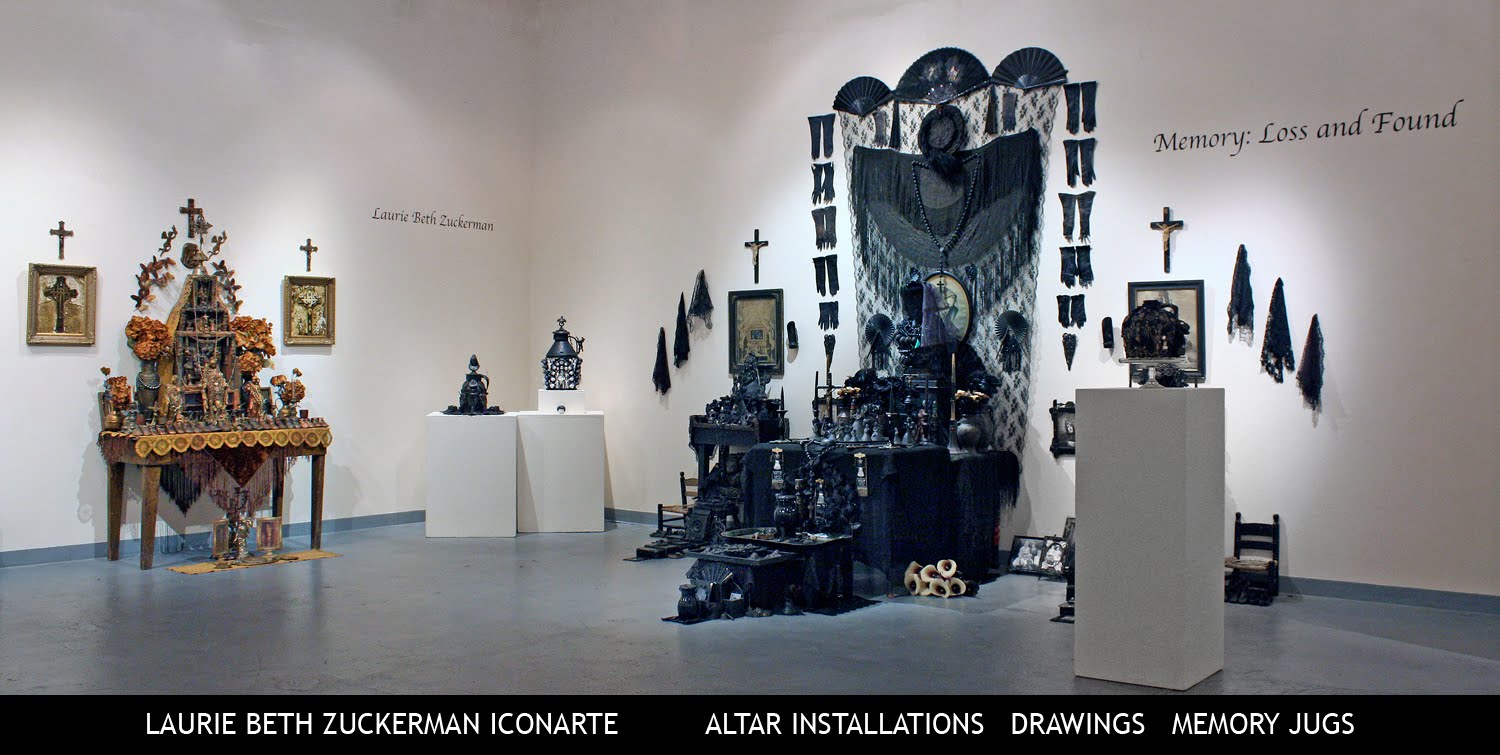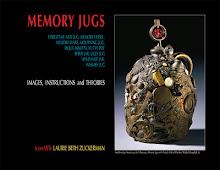

http://www.scenemagazine.info/online_this_month/DivArt.html
Laurie Zuckerman at the Loveland Museum/Gallery
reviewed by Sarah Vaeth for Scene Magazine October 2009
Laurie Zuckerman is a more-is-more artist. In her solo exhibition, Memento Mori: Deconstruction of the Nuclear Family, installations and assemblages of found objects take on visual power in proportion to their abundance.
Moments of gorgeous excess bring an obsessive personal involvement to her use of traditional craft forms of ritual and remembrance: altars and memory jugs. For Zuckerman, the emotionally charged objects (some nostalgic, some troubling) function as a time dredge. Memento Mori is a reflection upon the artist’s childhood in 1950s and early 60s Los Angeles – both the personal history of her family and the society that shaped them. By choosing objects that resonate with memories, Zuckerman re-creates the lost terrain of the past to explore and to analyze. She wryly confronts ambivalent feelings toward her fallible Hollywood parents and toward the faulty political landscape of the Atomic Age: creating a re-vision of childhood from the vantage of adult understanding.
Most of the installations are tied together with a dominant color, which unifies the objects, and has its own symbolic meaning. For example, Red Scare Altar Installation uses red in a complex metaphor. Zuckerman links the stereotyped “Red Man” of her father’s Western screenplays and the pervasive Cowboys-and-Indians games of a 50’s childhood, with Communist “Reds” of the same era. Both are adversaries in mythologized American conflicts. One was familiarized as child’s play. The other formed a fearful backdrop to Zuckerman’s childhood – routinely punctuated with the siren shrieks of air raid drills. Red also refers to the anger and volatility of her parents’ marital conflict, and the constant threat that the family would be “annihilated” by divorce.
Zuckerman chooses and arranges period objects in a way that colors children’s pass-times with an atmosphere of anxiety. Strikingly, in the center of the altar, toy Cowboys-and-Indians props (tom-toms, feathered headdresses, hatchets, pipes) are placed, together with Chinese and Russian figurines, in the shape of a bomber dropping missiles represented by darts, pick-up-sticks, and bowling pins.
Zuckerman reintroduces us to artifacts of recent American history – from souvenirs of the Cold War to ugly tokens of racism. But I’m intrigued by the private history she points to with strange symbolic clues – like the lobsters appearing in Red Scare Altar and its companion memory jugs. Zuckerman explains that these recall happy memories of family visits to a seafood restaurant, but more specifically they’re a double-sided recollection of Zuckerman’s mother: her favorite food and her “prickly” personality.
For the viewer, it takes some time to absorb the narrative richness of Zuckerman’s work. I found myself relying heavily on the museum’s various interpretive materials and on the artist’s own explanations to make out the more obscure connections. Inevitably, my attention was divided back-and-forth between the work and the supporting materials. Rewarding in the end – but I wonder whether Zuckerman could have integrated text or voice narration within the work itself, or some other intrinsic means to guide the viewer through the visual “story.”
Presentation issues notwithstanding, by weaving in symbols of personal reference, Zuckerman addresses uncomfortable social issues in a way that is sincere and self-reflective. Several works honor Anne Dooley, the African American housekeeper who cared for Zuckerman when she was a small child. Zuckerman lays bare a troubled mix of feelings about Dooley’s nurturing but subjugated role in her family. In American Vodou: The Black Madonnas Installation she represents the relationship through a diorama of white baby dolls in the care of stereotyped black mammy dolls: implicating her family in an exploitative system. Yet her childhood bond with Dooley was very real. Zuckerman identifies her as her “better mother.” Without alleviating the intentional discomfort of the piece, she subverts the mammy’s role by dressing the dolls in the garb of the Black Madonna (as used in Haitian Vodou), identifying them with a powerful female archetype. I see in this act a rectifying of the child-caregiver relationship, acknowledging Anne Dooley as a powerful force in Zuckerman’s life. But Zuckerman explains that the Vodou connection first came out of her reaction to the dolls themselves, which looked to her scarily like Vodou dolls.
American Vodou is visually the strongest of the installation pieces. Among the big floor-to-wall installations, it makes the best use of the gallery space: avoiding the intrusion of wall paint and office-pattern carpet that compromises the impact and historical illusion of the other large-scale works. The many smaller altars and intricately encrusted memory jugs are satisfyingly self-contained, well-spaced, and dramatically staged, making this a thoughtful exhibit on the whole.



No comments:
Post a Comment